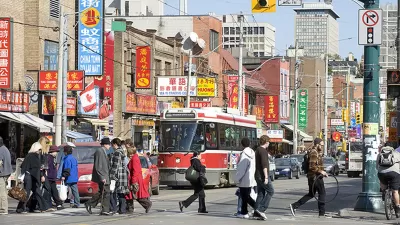A tough first week for the new LYNX Gold streetcar line in Charlotte inspired a review of the current research about the value of streetcars.

Andrew Keatts provides a recap of a tumultuous, unfortunate first week of operation for the Charlotte Streetcar. A few examples:
- "One streetcar crashed into an SUV after its driver lost control of its vehicle, city officials said."
- "A reporter laced up her sneakers and raced the streetcar, beating it to the end of the 1.4-mile line by a full two minutes."
Those hiccups indicate why, according to Keatts, the debate about the value of streetcars has persisted even as more and more cities roll out new streetcar projects. In fact, says Keatts, more and more academics are reaching consensus that streetcar lines do not make a wise investment.
Central to the challenges encountered by streetcars, however, are the sacrifices made in planning stages. Charlotte's new streetcar, for example, does not have a dedicated line and runs on 15-miniute headways during peak periods—not exactly the best model for frequent, reliable service.
The article goes on took a closer look at the emerging body of research, with special attention to the work of Jeff Brown, chair of the Department of Urban & Regional Planning at Florida State University. To summarize, Keatts writes: "A key point of emphasis among all the academic skeptics of the modern streetcar projects is that there isn’t anything inherently wrong with streetcars. The problem is with the way they’re executed."
FULL STORY: A streetcar named disaster? Debate ensues as latest project debuts

Planetizen Federal Action Tracker
A weekly monitor of how Trump’s orders and actions are impacting planners and planning in America.

Map: Where Senate Republicans Want to Sell Your Public Lands
For public land advocates, the Senate Republicans’ proposal to sell millions of acres of public land in the West is “the biggest fight of their careers.”

Restaurant Patios Were a Pandemic Win — Why Were They so Hard to Keep?
Social distancing requirements and changes in travel patterns prompted cities to pilot new uses for street and sidewalk space. Then it got complicated.

Platform Pilsner: Vancouver Transit Agency Releases... a Beer?
TransLink will receive a portion of every sale of the four-pack.

Toronto Weighs Cheaper Transit, Parking Hikes for Major Events
Special event rates would take effect during large festivals, sports games and concerts to ‘discourage driving, manage congestion and free up space for transit.”

Berlin to Consider Car-Free Zone Larger Than Manhattan
The area bound by the 22-mile Ringbahn would still allow 12 uses of a private automobile per year per person, and several other exemptions.
Urban Design for Planners 1: Software Tools
This six-course series explores essential urban design concepts using open source software and equips planners with the tools they need to participate fully in the urban design process.
Planning for Universal Design
Learn the tools for implementing Universal Design in planning regulations.
Heyer Gruel & Associates PA
JM Goldson LLC
Custer County Colorado
City of Camden Redevelopment Agency
City of Astoria
Transportation Research & Education Center (TREC) at Portland State University
Camden Redevelopment Agency
City of Claremont
Municipality of Princeton (NJ)



























